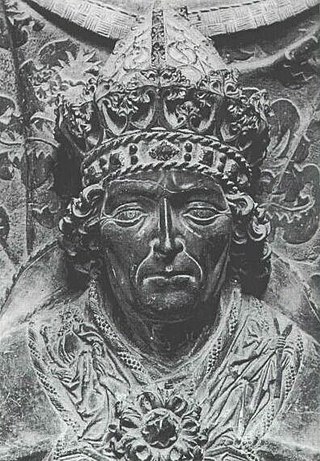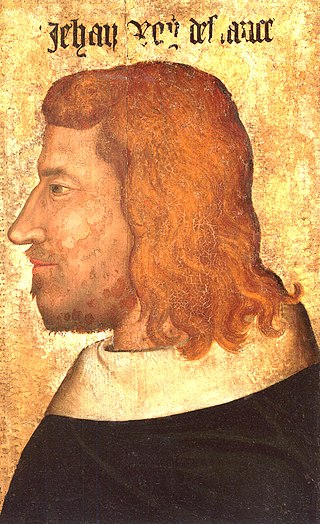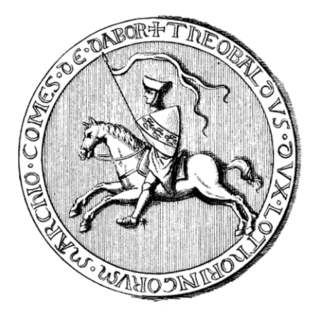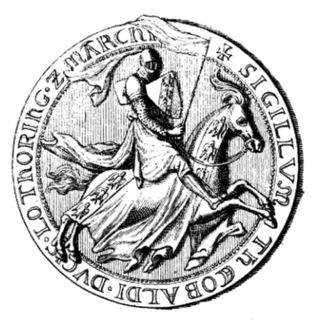Related Research Articles

Year 1125 (MCXXV) was a common year starting on Thursday of the Julian calendar.

John the Blind or John of Luxembourg, was the Count of Luxembourg from 1313 and King of Bohemia from 1310 and titular King of Poland. He is well known for having died while fighting in the Battle of Crécy at age 50, after having been blind for a decade. In his home country of Luxembourg, he is considered a national hero. Comparatively, in the Czech Republic, Jan Lucemburský is often recognized for his role as the father of Charles IV, Holy Roman Emperor, one of the more significant Kings of Bohemia and one of the leading Holy Roman Emperors.

Louis IV, called the Bavarian, was King of the Romans from 1314, King of Italy from 1327, and Holy Roman Emperor from 1328 until his death in 1347.

Year 1324 (MCCCXXIV) was a leap year starting on Sunday of the Julian calendar.

Rudolf I was the first King of Germany of the Habsburg dynasty from 1273 until his death.

John II, called John the Good, was King of France from 1350 until his death in 1364. When he came to power, France faced several disasters: the Black Death, which killed between a third and a half of its population; popular revolts known as Jacqueries; free companies of routiers who plundered the country; and English aggression that resulted in catastrophic military losses, including the Battle of Poitiers of 1356, in which John was captured.

Theobald I, also called the Troubadour and the Posthumous, was Count of Champagne from birth and King of Navarre from 1234. He initiated the Barons' Crusade, was famous as a trouvère, and was the first Frenchman to rule Navarre.
Edward I, was the count of Bar from 1302 to his death. He was a minor when he succeeded his father Henry III as count, so ruled initially under the regency of his uncles, John of Puisaye, Theobald, Bishop of Liège, and Renaud, Bishop of Metz.

Theobald I was the duke of Lorraine from 1213 to his death. He was the son and successor of Frederick II and Agnes of Bar.

Theobald II was the Duke of Lorraine from 1303 until his death in 1312. He was the son and successor of Frederick III and Margaret, daughter of King Theobald I of Navarre of the Royal House of Blois.

The House of Lorraine originated as a cadet branch of the House of Metz. It inherited the Duchy of Lorraine in 1473 after the death without a male heir of Nicholas I, Duke of Lorraine. By the marriage of Francis of Lorraine to Maria Theresa of Austria in 1736, and with the success in the ensuing War of the Austrian Succession (1740–1748), the House of Lorraine was joined to the House of Habsburg and became known as the House of Habsburg-Lorraine. Francis, his sons Joseph II and Leopold II, and his grandson Francis II were the last four Holy Roman emperors from 1745 until the dissolution of the empire in 1806. The House of Habsburg-Lorraine inherited the Habsburg Empire, ruling the Austrian Empire and then Austria-Hungary until the dissolution of the monarchy in 1918.

Theodoric I was the count of Bar and duke of Upper Lorraine from 978 to his death. He was the son and successor of Frederick I and Beatrice, daughter of Hugh the Great, count of Paris, and sister to the French king Hugh Capet.
Wigeric or Wideric was a Frankish nobleman and the count of the Bidgau and held the rights of a count within the city of Trier. He received also the advocacy of the Abbey of Saint Rumbold at Mechelen from King Charles the Simple of West Francia. From 915 or 916, he was the count palatine of Lotharingia. He was the founder of the House of Ardennes.

Sigfried was count in the Ardennes, and is known in European historiography as founder and first ruler of the Castle of Luxembourg in 963 AD, and ancestor and predecessor of the future counts and dukes of Luxembourg. He was also an advocate of the abbeys of St. Maximin in Trier and Saint Willibrord in Echternach.
The House of Ardenne–Verdun was a branch of the House of Ardenne, one of the first documented medieval European noble families, centered on Verdun. The family dominated in the Duchy of Lotharingia (Lorraine) in the 10th and 11th centuries. All members descended from Cunigunda of France, a granddaughter of the West Frankish king Louis the Stammerer. She married twice but all or most of her children were children of her first husband, Count Palatine Wigeric of Lotharingia. The other main branches of the House of Ardennes were the House of Ardenne–Luxembourg, and the House of Ardenne–Bar.

Baldwin of Luxembourg was the archbishop and elector of Trier and archchancellor of Burgundy from 1307 to his death. From 1328 to 1336, he was the administrator of the archdiocese of Mainz and from 1331 to 1337 of the dioceses of Worms and Speyer. He was one of the most prominent German prelates and statesmen of his age, and the most effective ruler of Trier during the late Middle Ages.
The War of the Succession of Champagne was a war from 1216 to 1222 between the nobles of the Champagne region of France, occurring within that region and also spilling over into neighboring duchies. The war lasted two years and de facto ended in 1218, but did not officially end until Theobald IV reached the age of majority in 1222, at which point his rivals abandoned their claims.

Otto IV, Margrave of Brandenburg-Stendal, nicknamed Otto with the arrow was the Margrave of Brandenburg from the House of Ascania from 1266 until his death.
Metz, the capital and the prefecture of the Moselle department in France, has a recorded history dating back over 2,000 years. During this time, it was successively a Celtic oppidum, an important Gallo-Roman city, the Merovingian capital of the Austrasia kingdom, the birthplace of the Carolingian dynasty, a cradle of Gregorian chant, and one of the oldest republics of the common era in Europe. As an important city in the heart of Europe and the crossroads of different cultures, Metz has variously experienced an integration into the Roman Empire, the period of christianization, the barbarian depredations, religious wars, the French Revolution, the Industrial Revolution, an annexation into the German Empire, and World War II.
References
- 1 2 3 Peter Fraser Purton, A History of the Late Medieval Siege, 1200-1500, (The Boydell Press, 2010), 143–144
- ↑ Zdeněk Žalud, "Financiers to the Blind King: Funding the Court of John the Blind (1310–1346)", in Roman Zaoral (ed.), Money and Finance in Central Europe during the Later Middle Ages (Palgrave Macmillan, 2016), 63-64.
- 1 2 Kelly DeVries and Robert Douglas Smith, Medieval Military Technology, 2nd edit., (University of Toronto Press, 2012), 138.